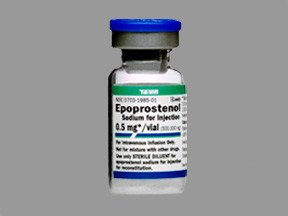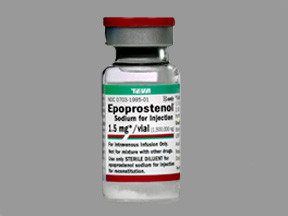EPOPROSTENOL - INJECTION
PHONETIC PRONUNCIATION: (E-poe-PROST-en-ol)
COMMON BRAND NAME(S): Flolan
GENERIC NAME(S): epoprostenol sodium (arginine)
Uses
USES: This medication is used to treat high blood pressure in the lungs (pulmonary arterial hypertension). It helps to increase your ability to exercise and improve symptoms such as shortness of breath and tiredness. It works by relaxing and widening the blood vessels (arteries) in the lungs and other parts of the body so that blood can flow more easily. This medication belongs to a class of drugs known as vasodilators.
How to use EPOPROSTENOL - INJECTION
HOW TO USE: When you first start using this medication, it must be given by a health care professional in a hospital or clinic. This medication is given as a continuous injection into the vein using an infusion pump, or as directed by your doctor. Follow all instructions from your health care professional about how to properly use and prepare this medication and the infusion pump. Learn how to properly care for your injection site and how to avoid infection. Also learn how to store and discard needles and medical supplies safely. Before using, check this product visually for particles or discoloration. If either is present, do not use the liquid, and contact your health care professional right away. If you have any questions about the use of this medication or the infusion pump, consult your health care professional. Do not suddenly decrease the dose or suddenly stop using this medication because doing either may lead to serious (rarely fatal) worsening of your condition. If you must stop this medication, gradually reduce the dose as directed by your doctor. Consult your doctor right away if your infusion is interrupted or if you develop worsening trouble breathing, dizziness, or weakness. To avoid interruptions in drug treatment, you should have a backup infusion pump and infusion sets available in case your equipment fails. Consult your health care professional for more information. The dosage is based on your medical condition, weight, and response to treatment. Your doctor may also direct you to use additional medications to treat your condition and prevent problems. Use all prescribed medications exactly as directed. Tell your doctor if your condition does not improve or if it worsens.
Side Effects
Precautions
Interactions
Overdose
Images
Reviews
Faq for EPOPROSTENOL - INJECTION
Epoprostenol injection is used for the treatment of pulmonary arterial hypertension (PAH) and to improve exercise capacity and symptoms in patients with PAH.
Epoprostenol is a prostacyclin analogue that works by dilating the blood vessels in the lungs, reducing the workload on the heart, and improving blood flow. This helps to lower blood pressure in the pulmonary arteries and improve symptoms associated with PAH.
Epoprostenol injection is given directly into a vein through a permanent central venous catheter. It is usually administered continuously 24 hours a day using an infusion pump.
Common side effects of epoprostenol injection include headache, jaw pain, flushing, nausea, diarrhea, dizziness, muscle pain, and injection site reactions.
The duration of treatment with epoprostenol injection varies depending on the individual patient's response and the severity of their condition. It is typically used long-term and may require lifelong treatment.
It is important to monitor blood pressure, heart rate, and oxygen saturation during epoprostenol infusion, as sudden discontinuation of the drug can lead to worsening symptoms and potentially life-threatening rebound effects. Close monitoring of liver function, blood counts, and fluid balance is also necessary.
Epoprostenol injection should only be used during pregnancy if the potential benefits outweigh the risks. It is not known whether the drug passes into breast milk, so breastfeeding should be avoided while receiving treatment.
Disclaimer
IMPORTANT: HOW TO USE THIS INFORMATION: This is a summary and does NOT have all possible information about this product. This information does not assure that this product is safe, effective, or appropriate for you. This information is not individual medical advice and does not substitute for the advice of your health care professional. Always ask your health care professional for complete information about this product and your specific health needs.


No Reviews Yet